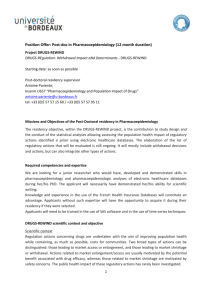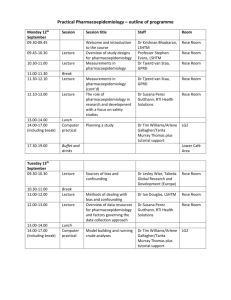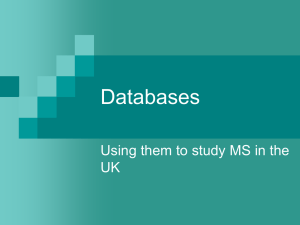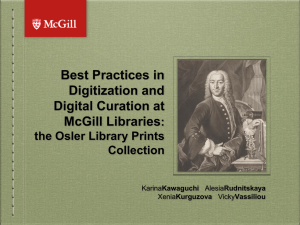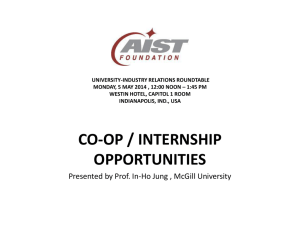Pharmacoepidemiology: Kris Filion
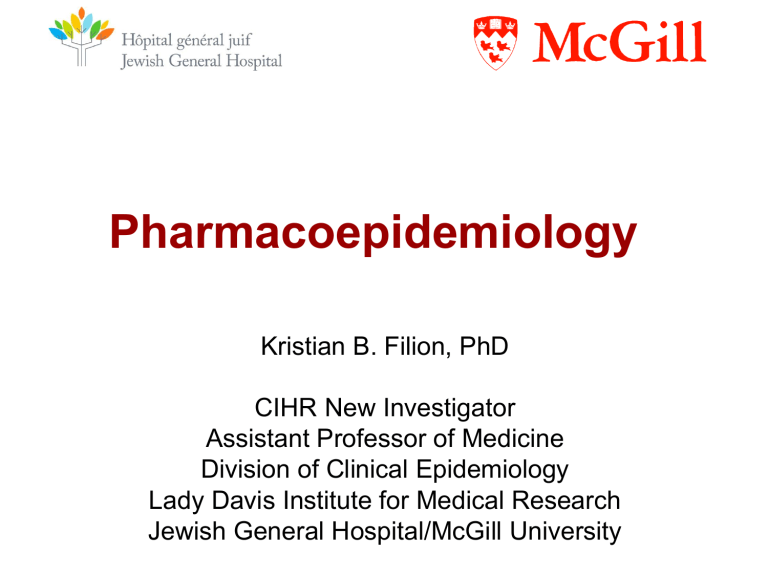
Pharmacoepidemiology
Kristian B. Filion, PhD
CIHR New Investigator
Assistant Professor of Medicine
Division of Clinical Epidemiology
Lady Davis Institute for Medical Research
Jewish General Hospital/McGill University
Definition
Pharmacoepidemiology is the study of the use of and the effects of drugs in large numbers of people.
The term pharmacoepidemiology obviously contains two components: “pharmaco” and
“epidemiology”.
Brian L. Storm (editor). Pharmacoepidemiology (fourth edition)
Drug Safety and Effectiveness
• Drug Safety:
– Post-Marketing Surveillance of Adverse Drug Effects
• Comparative Effectiveness Research:
– Designed to inform health-care decisions by providing evidence on the effectiveness, benefits, and harms of different treatment options
– Evidence is generated from research studies that compare drugs, medical devices, tests, surgeries, or ways to deliver health care http://effectivehealthcare.ahrq.gov/index.cfm/what-is-comparative-effectiveness-research1/
Drug Safety and Effectiveness
Network (DSEN)
• Joint CIHR-Health Canada initiative ($32M over 5 years)
• Part of the Food and Consumer Safety Action Plan
• Key objectives:
– Increase the available evidence on drug safety and effectiveness available to regulators, policy-makers, health care providers and patients
– Increase capacity within Canada to undertake high-quality postmarket research
• Team grants:
– Canadian Network for Observational Drug Effect Studies
(CNODES)
– Drug Safety and Effectiveness Network Collaborating Centre for
Prospective Studies http://www.cihr-irsc.gc.ca/e/40269.html
Potential Contributions of
Pharmacoepidemiology
• Information which supplements the information available from premarketing studies – better quantitation of the incidence of known adverse and beneficial effects
– Higher precision
– In patients not studied prior to marketing (e.g., the elderly, children, in pregnant women)
– As modified by other drugs and other illnesses
– Relative to other drugs used for the same indication
Brian L. Storm (editor). Pharmacoepidemiology (fourth edition)
Potential Contributions of
Pharmacoepidemiology (Cont.)
• New types of information not available from premarketing studies
– Discovery of previously undetected adverse and beneficial effects (e.g., Uncommon effects, Delayed effects)
– Patterns of drug utilization
– The effects of drug overdoses
– The economic implications of drug use
• General contributions of pharmacoepidemiology
– Reassurances about drug safety
– Fulfillment of ethical and legal obligations
Brian L. Storm (editor). Pharmacoepidemiology (fourth edition)
Dormandy et. al. Lancet 2005.
Bladder Cancer in PROACTIVE
P Value Pioglitazone
(n=2,605)
1,204 (46%) Any serious adverse event
Endpoint events 389 (15%)
Non-endpoint events 1,079 (41%)
Most common events (excluding endpoints)
Neoplasms
Malignant
112 (4%)
97 (4%)
Colon/rectal
Lung
Bladder
Bladder (after exclusion)*
16(1%)
15 (1%)
14 (1%)
6 (<1%)
* Cases remaining after blinded review
Placebo
(n=2,633)
1,275 (48%)
434 (16%)
1,150 (44%)
113 (4%)
99 (4%)
15 (1%)
12 (1%)
6 (<1%)
3 (<1%)
0.110
0.123
0.099
0.834
0.544
0.069
0.309
Dormandy et. al. Lancet 2005.
Azoulay et. al. BMJ 2012.
Thiazolidinediones and Risk of
Bladder Cancer
N (%)
Use of Thiazolidinediones
Cases*
(n=376)
Controls*
(n=6,699)
Adjusted
Rate Ratio
(95% CI)†
1.00 (Ref.) Never use of any thiazolidinedione
Exclusive ever use of pioglitazone
Exclusive ever use of rosiglitazone
Ever use of both pioglitazone and rosiglitazone
319 (84.8)
19 (5.1)
36 (9.6)
2 (0.5)
5,856 (87.4)
191 (2.9)
595 (8.9)
56 (0.8)
1.83 (1.10, 3.05)
1.14 (0.78, 1.68)
0.78 (0.18, 3.29)
*Matched on year of birth, year of cohort entry, sex, and duration of follow-up.
† Adjusted for excessive alcohol use, obesity, smoking status, HbA
1c
, previous bladder conditions, previous cancer
(other then non-melanoma skin cancer), Charlson comorbidity score, and ever use of other antidiabetic agents
(metformin, sulfonylureas, insulin, and other oral hypoglycaemic agents).
Azoulay et. al. BMJ 2012.
Other Examples of
Pharmacoepidemiology at McGill
Other Examples of
Pharmacoepidemiology at McGill
Other Examples of
Pharmacoepidemiology at McGill
International Psychogeriatrics
Assessing the cumulative effects of exposure to selected benzodiazepines on the risk of fall-related injuries in the elderly
Marie-Pierre Sylvestre, Michal Abrahamowicz, Radan Čapek and Robyn Tamblyn
Other Examples of
Pharmacoepidemiology at McGill
Pharmacoepidemiology
Investigators at McGill
• Laurent Azoulay
• Sacha Bernatsky
• Jean-François
Boivin
• Paul Brassard
• James Brophy
• Jaimie Caro
• Pierre Ernst
• Kristian Filion
• Elham Rahme
• Michel Rossignol
• Samy Suissa
• Vicky Tagalakis
• Robyn Tamblyn
Prospective Jobs
• Academia
• Government
• Consulting
• Pharmaceutical Industry
THANK YOU!
Kristian.filion@mcgill.ca
